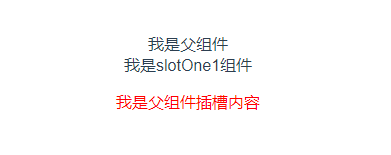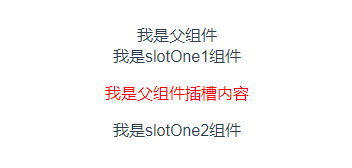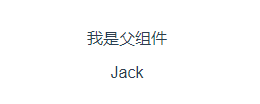vue中的插槽————slot
什么是插槽?
- 插槽(Slot)是Vue提出来的一个概念,正如名字一样,插槽用于决定将所携带的内容,插入到指定的某个位置,从而使模板分块,具有模块化的特质和更大的重用性。
- 插槽显不显示、怎样显示是由父组件来控制的,而插槽在哪里显示就由子组件来进行控制
- 父组件拥有结构,子组件用slot占位
- 作用域插槽是一种子传父传参的方式,解决了普通slot在parent中无法访问child数据的去问题;
怎么用插槽?
默认插槽
父组件
<template> <div> 我是父组件 <slotOne1> <p style="color:red">我是父组件插槽内容</p> </slotOne1> </div> </template>
在父组件引用的子组件中写入想要显示的内容(可以使用标签,也可以不用)
子组件(slotOne1)
<template> <div class="slotOne1"> <div>我是slotOne1组件</div> <slot></slot> </div> </template>
在子组件中写入slot,slot所在的位置就是父组件要显示的内容

- 当然再父组件引用的子组件中也可以写入其他组件
父组件
<template> <div> 我是父组件 <slotOne1> <p style="color:red">我是父组件插槽内容</p> <slot-one2></slot-one2> </slotOne1> </div> </template>
子组件(slotOne2)
<template> <div class="slotOne2"> 我是slotOne2组件 </div> </template>

具名插槽
子组件
<template> <div class="slottwo"> <div>slottwo</div> <slot name="header"></slot> <slot></slot> <slot name="footer"></slot> </div> </template>
在子组件中定义了三个slot标签,其中有两个分别添加了name属性header和footer
父组件
<template> <div> 我是父组件 <slot-two> <p>啦啦啦,啦啦啦,我是卖报的小行家</p> <template slot="header"> <p>我是name为header的slot</p> </template> <p slot="footer">我是name为footer的slot</p> </slot-two> </div> </template>
在父组件中使用template并写入对应的slot值来指定该内容在子组件中现实的位置(当然也不用必须写到template),没有对应值的其他内容会被放到子组件中没有添加name属性的slot中

插槽的默认内容
父组件
<template>
<div>
我是父组件
<slot-two></slot-two>
</div>
</template>
子组件
<template> <div class="slottwo"> <slot>我不是卖报的小行家</slot> </div> </template>
可以在子组件的slot标签中写入内容,当父组件没有写入内容时会显示子组件的默认内容,当父组件写入内容时,会替换子组件的默认内容

编译作用域
父组件
<template> <div> 我是父组件 <slot-two> <p>{{name}}</p> </slot-two> </div> </template> <script> export default { data () { return { name: 'Jack' } } } </script>
子组件
<template> <div class="slottwo"> <slot></slot> </div> </template>

作用域插槽
- 作用域插槽是一种子传父传参的方式,解决了普通slot在parent中无法访问child数据的去问题;
子组件
<template> <div> 我是作用域插槽的子组件 <slot :data="user"></slot> </div> </template> <script> export default { name: 'slotthree', data () { return { user: [ {name: 'Jack', sex: 'boy'}, {name: 'Jone', sex: 'girl'}, {name: 'Tom', sex: 'boy'} ] } } } </script>
在子组件的slot标签上绑定需要的值
父组件
<template> <div> 我是作用域插槽 <slot-three> <template slot-scope="user"> <div v-for="(item, index) in user.data" :key="index"> {{item}} </div> </template> </slot-three> </div> </template>
在父组件上使用slot-scope属性,user.data就是子组件传过来的值

综合,利用props属性传值,作用域插槽
父组件,
<template>
<div>
<p>vue 高级特性</p>
<hr>
<ScopedSlotDemo :url="website.url">
<template slot-scope="slotProps">
{{slotProps.slotData.title}}
</template>
</ScopedSlotDemo>
</div>
</template>
<script>
import ScopedSlotDemo from './ScopedSlotDemo'
export default {
data() {
return {
name:'小米',
website: {
url: 'http://imooc.com/',
title: 'imooc',
subTitle: '程序员的梦工厂'
},
};
},
components:{
ScopedSlotDemo
}
};
</script>
<style scoped lang="css">
</style>
子组件
<template>
<a :href="url">
<slot :slotData="website1">
{{website1.subTitle}} <!-- 默认值显示 subTitle ,即父组件不传内容时 -->
</slot>
</a>
</template>
<script>
export default {
props: ['url'],
data() {
return {
website1: {
url: 'http://wangEditor.com/',
title: 'wangEditor',
subTitle: '轻量级富文本编辑器'
}
}
}
}
</script>